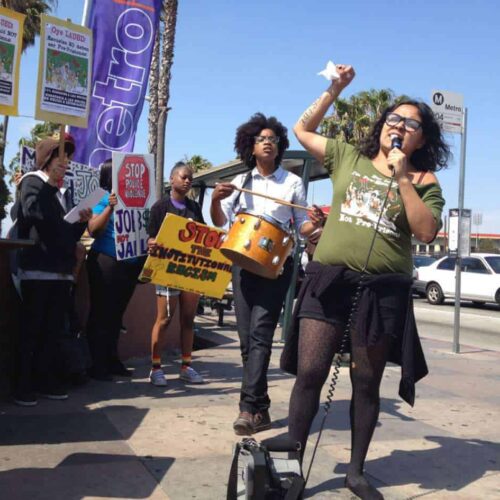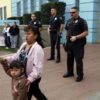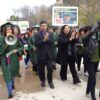Introduction
Alexander Johnson arrived at Barack Obama Global Preparatory Academy to pick up his 12-year-old after school on May 19, 2011. When his son, A.J. didn’t appear, Johnson went inside the Los Angeles middle school. What he found was devastating.
A.J. and a friend had gotten into a physical altercation over a basketball game, and school staff had summoned not parents, but police officers. Neither boy was injured, and the school ended up suspending his son for only one day, Johnson said. But officers wrote up a court citation and decided, on the spot, to also handcuff and arrest A.J. as the alleged aggressor — after what Johnson believes was only a cursory look into what had happened.
Despite Johnson’s pleas for another solution to what the citation said was a “mutual fight,” officers drove A.J. to a station, booked him, fingerprinted him and took a mug shot before releasing him. The family hired a lawyer, and school staff later apologized. But Johnson and his wife still can’t comprehend why school officials got police involved. And while school police say they have a duty to fight crime, the Johnsons can’t help but think that officers arrested their son because of snap judgments about African-American kids in South Central Los Angeles.
“He’s got good grades and he’s never been in trouble,” Johnson said he kept telling police. “Tell it to the judge,” he said police replied.
Broader concerns
What happened to the Johnsons’ son is the type of incident — in Los Angeles and elsewhere — that has the Obama Administration’s Department of Education and a growing number of juvenile-court judges deeply concerned.
In fact, the issue of police citations has been included in a federal review of discipline-reform plans that the Los Angeles Unified School District – under pressure to reduce high rates of suspensions of black students — was required to submit earlier this year to the Education Department’s Office for Civil Rights.
“Generally speaking, in all but the most serious cases we would hope that district officials review a range of options … before referring students to the court system,” the department’s assistant secretary for civil rights, Russlynn Ali, told the Center for Public Integrity in an interview that touched on both Los Angeles and national trends.
Months ago, the Los Angeles district failed to submit any records of police citations or arrests of students to Ali’s office so they could be included in the office’s most recent mandatory Civil Rights Data Collection. The collection of those 2009-2010 statistics from most U.S. schools was an unprecedented attempt by the Education Department to assess an apparent national upsurge in referrals of students to law enforcement.
Los Angeles’ data and New York City’s, too, were conspicuously missing.
But in April, the Center for Public Integrity and a Los Angeles civil rights group, the Labor-Community Strategy Center, obtained and analyzed a large portion of the L.A. data that Ali’s office had expected to get.
The data — obtained through a public records act request — contained tens of thousands of citations to lower-level juvenile court issued by Los Angeles Unified’s own police force from 2009 through 2011.
The data don’t include arrests, which are recorded separately, or separate citations that officers referred directly to a higher-level delinquency court, where Johnson’s son ended up. The data don’t include tickets written by city police either.
But the citations do likely represent the bulk of police-student interactions, and reveal how pervasive the ticketing of students has become in this large metropolitan district, which is struggling with high dropout rates and budget cuts.
The Center found that Los Angeles’ school officers, part of the largest school police force in the country, issued more than 33,500 tickets to students between 10 and 18 years old over three years. That worked out to about 30 citations a day, every day.
More than 40 percent of these court citations were to kids 14 and younger, mostly for disturbing the peace, followed by daytime curfew violations, including tardiness, and scattered tickets for cigarettes, lighters, marijuana, vandalism or having graffiti “tools,” such as a Sharpie. Black students, about 10 percent of the district’s student body, received 15 to 20 percent of all tickets, depending on the year, and Latino students, 74 percent of enrollment, also received a disproportionate number.
Additional Center analysis also shows that these lower-level court citations were highly concentrated in low-income areas where children of immigrants and African-American families attend school. Last year, there were more than 25 middle schools in such areas where at least 50 citations to lower-level court were given to students, many of them 11 and 12 years old. At least a dozen of those schools showed 70 or more tickets issued to students, who were overwhelmingly black and Latino.
After initial findings from the data were disclosed in media reports in late April, students and parents held protests in early May. The Labor-Community Strategy Center urged that the district cut tickets by 75 percent and adopt a moratorium on citations until more studies were done. District police officials declined to stop ticketing, but have engaged in community discussions about reforms.
Ali said she couldn’t comment directly on “independently gathered” Los Angeles statistics. But, she said, “the data you cite reveal, and the recent Civil Rights Data Collection data show nationally, that students of color are disproportionately disciplined.”
National trends
In March, Ali’s office revealed the results of what it had gleaned from districts nationwide that had complied and submitted their arrest and citation numbers for 2009-2010. The findings were stark: Black students, 18 percent of enrollment, represented 42 percent of school-based referrals to police. Latinos, 24 percent of enrollment, were 37 percent of school-related arrests.
“While the magnitude of the problem is something those of us involved with civil rights enforcement have been keenly aware of, I would not be telling the truth if I did not say that I found the data surprising and disturbing on a personal level,” Ali said.
“Mind you,” she said, “racial disparities revealed by data alone don’t constitute a civil rights violation . . . But at minimum, they should certainly be cause for concern and lead to conversations about why the disparities exist and what can be done to ensure fair learning opportunities for all students.”
Ali’s office has offered aid to help districts comply with another upcoming request that’s part of a new national collection of data. The L.A. district told the Center it was too difficult to compile 2009-2010 data from various city police agencies as well as from school police.
Because of concerns about school police in New York City – some students have sued there over alleged excessive force – that city now requires quarterly reports of how many students have been arrested and cited. The first report in February showed that officers issued an average of six tickets daily to New York City students every day during a 90-day period.
That’s fewer than the 30 daily low-level citations that the Center found were issued on average in Los Angeles. The L.A. district, with about 670,000 students, is the second largest public school district in the United States. New York City’s is the largest, with more than 1 million pupils.
Finding a balance
David Goldberg, an officer of the United Teachers Los Angeles Union, told the Center that teachers, hard hit by California’s budget cuts, are frustrated because so many students come to school today troubled by family problems and “with more needs than ever.” Some teachers feel strongly about getting tough on kids who fight or disrupt teaching, Goldberg said. But, he said, “there is probably a growing number of teachers who feel we need a different strategy, that this (citing of students) is not working.”
Among the middle schools in the district, Gompers Middle School in working-class South Los Angeles topped the list at 145 citations last year.
More than 100 tickets at Gompers were for disturbing the peace by fighting or threatening to fight. Two citations were for using offensive language aimed to provoke an altercation. The school’s student body is one-third black and two-thirds Latino. It is one of Los Angeles’ “turnaround” public schools operated by a nonprofit tasked with improving students’ relatively low rates of proficiency in English and math.
Los Angeles Deputy School Police Chief Tim Anderson told the Center that the district policy is for school police to respond to crimes, not discipline matters.
“We’re not counselors,” he said. “We’re not social workers.”
He said officers decline to get involved if they decide a school problem does not rise to a crime.
Anderson said the department of 340 officers and staff use a “matrix” to decide where to deploy officers. The district minimum for high schools is one officer. But if a high school or middle-school is in an area surrounded by a neighborhood with a high crime rate, Anderson said, more officers are sent to those schools to enhance students’ safety.
This year, for example, more police were sent to Gompers after two 7th graders pulled out a knife and gun while arguing.
Civil rights groups fear that because of this concern for safety, ironically, black, Latino and low-income students are being subjected to unequal police scrutiny over minor matters and more searches than kids in affluent areas.
Zoe Rawson, an attorney with the Labor-Community Strategy Center, who has defended students in court, said: “We are both policing students of color differently because they live in these areas and rely on the public education system, and we are using the police and the courts as a punitive tactic for school discipline despite evidence that it is ineffective, harmful and wasteful.”
A word from the judges
Prominent Los Angeles juvenile-court judges are also arguing that courts are clogged with students whose futures could be harmed more than helped by summonses. A recent report by the Los Angeles County School Attendance Task Force, which included judicial, police and school representatives, concluded: “Involving youth in the criminal justice system has the detrimental and unintended consequences of reducing their chances of graduating high school.”
The task force report cited an Arizona State University criminologist who found that a first-time court appearance in high school increases a student’s odds of dropping out by at least a factor of three. The impact was greater for a student who was only marginally delinquent.
Some of Los Angeles’ inner-city schools have struggled with dropout rates as high as 50 percent. The citations examined by the Center were concentrated at those schools, as well as at middle schools that feed students into those secondary schools.
In a written response to the Center’s findings in April, the district said: “School-yard fights have been a part of school life for a long time. Many intervention programs are in place but young students do not always follow the program . . . A visit to a juvenile-court referee should help make the student aware that fighting is not tolerated in society.”
Christopher Ortiz, the district’s school operations chief, said in a more recent interview that school administrators are told that that the role of school police is clear: “School police do not do classroom management.” Ortiz said the district is continuing to institute what’s known as “positive behavior support” to deal with fights and disruptive behavior.
The court citations examined by the Center do not identify which resulted from behavior on school grounds or nearby.
Courts in a squeeze
Up to now, most kids in Los Angeles with lower-level citations have been summoned to an “informal” juvenile court. They must appear with a parent during court hours, which means students miss school and the parent misses work. Students can face hundreds of dollars in fines, and if they don’t show up to court – many are afraid to tell parents about a ticket – their infraction has a misdemeanor offense added on.
Michael Nash, the presiding judge of Los Angeles’ juvenile courts, said judges in the region plan to consult with peers in other states — in Atlanta, Ga., for example – who have reduced school-based ticketing for minor offenses with counseling practices.
A looming concern in Los Angeles is the planned closure this summer of all the county’s informal juvenile courts due to budget cuts. Nash and Judge Donna Quigley Groman, who is on the bench in full delinquency court, say the plan is to send students who get tickets to probation officers who will manage, the judges hope, mostly out-of-court diversion programs.
Civil-rights groups, however, fear that many more kids will now end up in delinquency court.
Groman doesn’t want that either. “When I see 11-year-olds in my courtroom it really causes my blood to boil,” she told the Center. “I notice there are a lot more young kids showing up here.”
She described an 11-year-old girl who was in her court this month because school police cited her for battery – a more serious charge than disturbing the peace – after she got into a school fight. There is no research, Groman said, showing that sending 11-year-olds to court and putting them on probation is effective.
“It makes them worse,” she said. Schools, she said, are the best place to handle behavior problems. “There are inner-city schools with kids with problems, and they need our help to deal with them” she said.
Jerod Gunsberg, the Johnson boy’s attorney, said that it took six months to get that 12-year-old’s assault charges dismissed in delinquency court. Gunsberg said a probation officer told him she didn’t understand why A.J.’s case was in that court, but that he wasn’t the first student to be referred from his school. The court put A.J. into an informal diversion program of four sessions of anger-management counseling, asked him to write a book report and urged him to continue to get good grades.
The district said no one at Barack Obama or the district could discuss the case because of confidentiality laws. Statistics show that at least 50 citations for lower-level juvenile court were issued at Barack Obama last year.
The Johnsons pulled A.J. out of Barack Obama for a while, but had to drive him a long distance to a more affluent school in Santa Monica. They noticed there were not a lot of police cars patrolling there. At Barack Obama, when his son got into his first fight, “it all went south when police got involved,” Alexander Johnson said. “They didn’t have anyone to handle discipline, and they told me everything goes straight to police.”
The Johnsons put A.J. back in Barack Obama this year, and the school welcomed him back, his parents said, and assured them that a new staffer had been appointed to handle discipline.
Gunsberg said that, unfortunately, even though charges were dismissed and A.J. was not required to formally admit to any wrongdoing, his mug shot and fingerprints remain on file with police until he can try to have them sealed in five years or when he turns 18.
Center for Public Integrity data editor David Donald contributed to this report.
Read more in Education
Criminalizing Kids
When schools call police on kids
Schools refer tens of thousands of students to law enforcement every year. Black children and students with disabilities get the brunt of it.
Criminalizing Kids
Our reports show why school police are under fire after Floyd protests
Districts removing cops or considering it after Black Lives Matter marches





Join the conversation
Show Comments